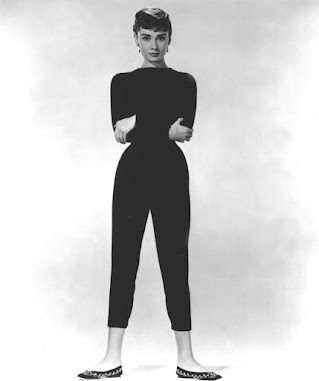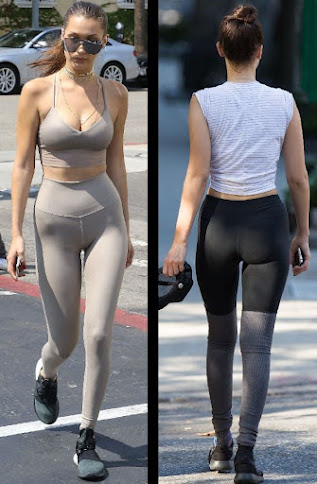Legging (pronounced leg-ing)
(1) A covering for the leg, usually extending from the
ankle to the knee but sometimes higher, worn by soldiers, riders, workers,
etc.
(2) The pants of a two-piece snowsuit.
(3) In the plural, as leggings, (1) close-fitting
trousers worn by mostly by women and girls (as fashion items) & (2) close
fitting trousers worn as support in sporting competitions.
(4) In
slang, as “legging it”, (1) to proceed somewhere by foot or (2) to proceed
somewhere by any means with some alacrity, a variation of the latter being “shake
a leg”.
1745–1755: The construct was leg(g) + -ing (the more
illustrative alternative spelling being leggin (leg(g) + in). The noun leg was from the Middle English leg & legge, from the Old Norse leggr
(leg, calf, bone of the arm or leg, hollow tube, stalk), from the Proto-Germanic
lagjaz & lagwijaz (leg, thigh) which may have been from the primitive Indo-European
(ǝ)lak- or lēk- (leg; the main muscle of the arm or
leg). It was cognate with the Scots leg
(leg), the Icelandic leggur (leg,
limb), the Norwegian Bokmål legg (leg),
the Norwegian Nynorsk legg (leg), the
Swedish Swedish lägg (leg, shank,
shaft), the Danish læg (leg), the Lombardic
lagi (thigh, shank, leg), the Latin
lacertus (limb, arm) and the Persian لنگ (leng). It almost wholly displaced the native Old
English sċanca (from which Modern English gained shank) which may have been
from a root meaning “crooked”. The origin
of the Germanic forms remains uncertain and the Old Norse senses may be
compared with Bein (“leg” in German) which in the Old High German meant "bone,
leg".
The slang use
is derived from the circa 1500 verb which from the start was usually in the form
“leg it”, meaning “proceed on foot by walking or running”. The meaning "part of pants which cover
the leg" is from 1570s and by the 1870s as an adjective it had a acquired
the salacious hint of artistic displays focused on the female form with most of
the leg exposed. In the jargon of the theatre, leg-business was slang for "dance; ballet." The idea of a leg as "a part or stage of
a journey or race" dates only from 1920 and was based on the earlier sense
(from 1865) applied to sailing ships which meant "a run made by a ship on
a single tack when beating to windward" which sailors defined as long leg
or short leg, the notion being the leg ending when the direction had to be
altered. The theatre slang “shake a leg”
by 1869 meant “dance” and this by 1800 spread to the general population where
it meant "hurry up". To be “on
(one's) last legs” meant “close to death”, the earliest known instance in print
being from the 1590s. To take “leg bail”
was late eighteenth century underworld and legal slang for "run away"
in the sense either of escaping from apprehension or not appearing in court as
summonsed. The phrase “having the legs”
meant “enduring success, staying power" emerged in the late 1960s to
describe Broadway shows which enjoyed an extended session while “long legged”
was an automotive term which referred to a vehicle with an ability effortlessly
to cruise at high speed. Leg-side and off-side are the two hemispheres of a cricket ground, divided down the middle of the batting pitch. The leg-side is that closest to a batsman's legs while the off-side is that closest to the bat when the normal batting position is adopted; leg and off-side thus swap identities depending on whether the batsman is left or right-handed. The distinction explains the origin of many fielding positions (long off, deep backward square leg, leg slip etc) but, confusingly, the leg designation is only used for the "leg quarter" of the field, positions forward of square leg using "on" (as opposed to "off") thus long on, long off etc.
The
suffix –ing was from the Middle English -ing,
from the Old English –ing & -ung (in the sense of the modern -ing, as a suffix forming nouns from
verbs), from the Proto-West Germanic –ingu
& -ungu, from the Proto-Germanic –ingō & -ungō. It was cognate with the Saterland Frisian -enge, the West Frisian –ing, the Dutch –ing, The Low German –ing
& -ink, the German –ung, the Swedish -ing and the Icelandic –ing;
All the cognate forms were used for the same purpose as the English -ing). Legging & leggings are nouns, legging (in
its slang sense) is a verb and legginged is an adjective. The noun plural is leggings.
Henry VIII (1491–1547; King of England 1509-1547) & Lindsay Lohan illustrate the enduring appeal of leggings.
In the West, so ubiquitous for so long have been leggings
that they seem less a trend than a fixture but historians of fashion have noted
that leggings have been in and out of style since first they were worn in the
fourteenth century, “going out” and “coming back” for hundreds of years. Although now (except in sport or hidden under
layers when worn by scuba-divers, mountaineers or those on ski fields) associated
almost exclusively with women and girls, leggings appear first to have been
worn by men in fourteenth century Scotland. The early leggings were two separate,
hip-high, boot-like apparatuses made of either leather or chainmail, intended
for both civilian and military use and they evolved into thick garments (like
tights), worn under cotehardies (a
kind of blend of a cardigan, coat and hoodie (ankle-length for women, shorter
for men), from the Old French cote-hardie,
the construct being cote (coat) + hardie (hardy)) for the mid-Renaissance
until the late eighteenth century (although they fell from favor with women more
than a hundred years earlier. Men abandoned
them too as the combination of trousers, shirts and jackets became the standard
form of dress, something which endures to this day.
Audrey Hepburn in capri pants, 1954.
The first modern day
revival was stimulated by fashion designers in the 1950s using the capri pants
in their early post-war shows, the slender waist-defining cropped black pants ideal
emphasizing the preferred shape of the era and while they weren’t the now familiar
skin-tight leggings, they offered a dramatic contrast with the wider-leg styles
associated with the 1940s. It was the
debut of Lycra (spandex) in 1959 which made possible leggings in their modern
form and fashion photographers soon honed techniques best suited when they were
paired with the new generation of mini-skirts, the lines and allure of leg, paradoxically,
emphasized when covered.
Bella Hadid (b 1996) in leggings coming from and going to the gym. She looks good, coming or going.
The industry notes a brief lull in their popularity during the hippie era
when many restraining devices were discarded (and sometime even ceremonially
burned) but by the late 1970s they were back and the trend accelerated in the 1980s
when the new popularity of active-wear spread beyond the gym to the street and,
significantly, the new influencer platform of the music video and the stretchy
things survived the onslaught of leg warmers.
Lycra was well suited to bright, shiny colors and the leotard over leggings
look became a motif of the decade. It
was perhaps a bit much and things got darker and baggier in the 1990s but the
practicality of the things was ultimately irresistible and the innovation of stirrup-leggings was a harbinger of the new century.
It does seem they’re now here to stay and full-length, liquid leggings have
in a sense replaced pants, something which upset some Middle-Eastern airlines
which were compelled to remind passengers their dress code allowed pants for
women but that “leggings are not pants”, a rule enforced in the West on female
visitors to some men’s prisons.
Gym pants are a variation of leggings. Cut usually to calf-length, the design is optimized for exercise. Ina-Maria Schnitzer (b 1986; who modeled as Jordan Carver) demonstrates the advantages.

























